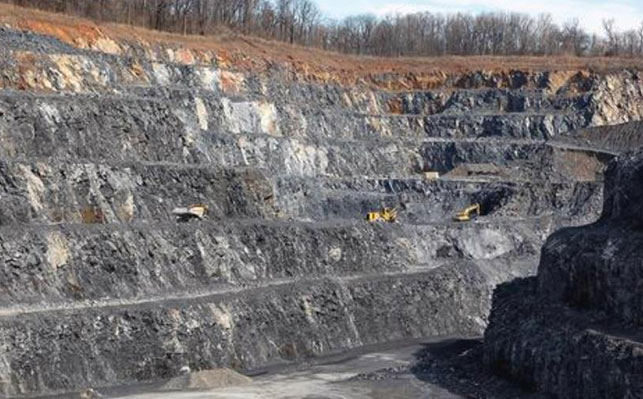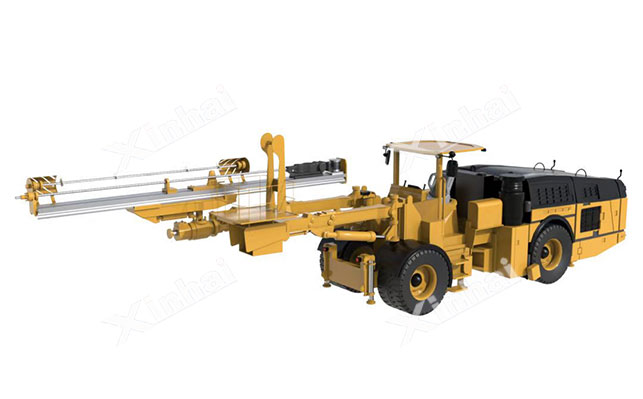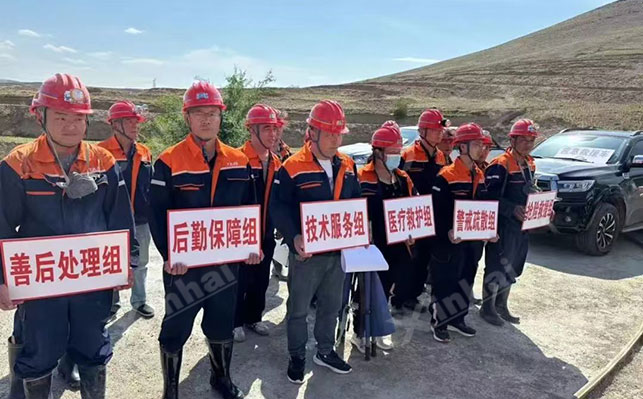
15311826613
Click to add WeChatAs an important method of modern mining, open-pit mining plays a key role in the mining of ore deposits with shallow burial and wide distribution range due to its high efficiency and convenience. Its operation process covers key links such as drilling, blasting, mining, transportation and soil discharge. Each link is closely connected and works in coordination to jointly ensure the efficient mining and rational utilization of mineral resources.
Drilling is the basic link of open-pit mining. Its purpose is to create conditions for subsequent blasting operations and drill holes of specific specifications on the ore body or covering rock. This link directly affects the blasting effect and the quality of ore crushing, and thus is related to the overall mining efficiency. During the operation, the precise design of drilling parameters is the core of the drilling operation. Engineers need to determine parameters such as blasthole diameter, depth, spacing and row spacing based on the properties of the ore and the requirements of the blasting design.

Modern drilling operations mainly use equipment such as rotary drills and down-the-hole drills.
Cone drill: Suitable for medium-hard and hard rocks. The drill rod drives the bottom cone drill bit to rotate, and the rock is crushed by the rolling and cutting action of the cone. During the drilling process, the air compressor of the drill rig sends high-pressure air to the bottom of the hole through the drill rod, blows the broken rock chips out of the hole, and forms a continuous drilling operation.
Down-the-hole drill: Commonly used for medium-hard and below rocks, its impactor directly produces an impact at the bottom of the hole to crush the rock, and uses compressed air to discharge slag.
Blasting is a key process in open-pit mining. It uses the energy generated by the explosion of explosives to crush ore and rock to a size suitable for mining and loading. The quality of blasting directly affects the subsequent mining and loading efficiency, transportation cost and ore depletion rate. In the blasting design stage, it is necessary to comprehensively consider factors such as ore body characteristics, terrain conditions, and surrounding environment, and select appropriate blasting methods, such as shallow hole blasting, deep hole blasting, and chamber blasting. Deep hole blasting is the most widely used in open-pit mining because of its advantages of high efficiency and low cost. The depth of the blasthole is usually more than 10 meters and the diameter is 100-300 mm.
In addition, the selection of explosives and the charging structure are also crucial to the blasting effect. According to the rock properties and blasting requirements, ammonium nitrate explosives, emulsion explosives, etc. can be selected. Ammonium nitrate explosives have low cost and are suitable for general rocks; emulsion explosives have the characteristics of strong water resistance and good explosion performance, and are often used in humid environments. In terms of charging structure, continuous charging and interval charging can be used. Interval charging can improve the energy distribution of explosives, reduce the rate of large blocks, and improve the quality of blasting.
With the development of technology, digital blasting technology has gradually become popular. Through three-dimensional geological modeling and blasting simulation software, the blasting process can be visualized and simulated, the blasting effect can be predicted, and the blasting parameters can be optimized.
Loading operations are the process of loading blasted ore and rock into transportation equipment, and its efficiency directly affects the production capacity of the mine. At present, excavators, electric shovels, front-end loaders and other equipment are mainly used for loading operations.

Excavator: It is the most commonly used mining and loading equipment in open-pit mining. It has strong digging force and flexibility, and is suitable for various types of ores and rocks.
Electric shovel: It is used to load large pieces of ore. Front-end loaders have the advantages of strong mobility and flexible operation, and are often used to assist mining and loading and short-distance transportation.
The selection of mining and loading equipment needs to comprehensively consider factors such as the nature of the ore and rock, the size of the block, and the scale of mining. For ores with greater hardness and large blocks, equipment with large digging force and large bucket capacity should be selected; for loose materials, small loaders can be selected to improve work efficiency. In addition, intelligent mining and loading technology is emerging. Some equipment is equipped with automatic weighing systems, operation monitoring systems, etc., which can monitor the mining and loading weight, operation position and other data in real time to avoid overloading and unbalanced loading, and improve mining and loading accuracy and safety.
The transportation operation is responsible for transporting the mined ore and rock from the working face to the ore dressing plant and spoil dump, and is the key link between mining and loading and subsequent processes. According to factors such as transportation distance and ore output, different modes of transportation can be selected, mainly including road transportation, rail transportation, belt transportation, etc.
Road transportation: high flexibility and strong adaptability, suitable for medium and short distance transportation. Large mining dump trucks are the main equipment for road transportation, with a load capacity of more than 100 tons, which can quickly and efficiently transport ore out of the working face.
Railway transportation: suitable for long-distance and large-volume ore transportation, with the advantages of low transportation cost and large transportation capacity. In some large open-pit coal mines, heavy-load railway trains are often used for coal transportation, and the transportation volume of a train can reach thousands of tons.
Belt transportation: suitable for continuous transportation over complex terrain and long distances. It continuously transports ore to the destination through a belt conveyor, with the advantages of high transportation efficiency, low energy consumption, and environmental protection. In some large open-pit metal mines, tubular belt conveyors are used to achieve closed transportation of ore, reducing dust pollution and material loss. In addition, the application of unmanned transportation systems in transportation operations is becoming more and more widespread. Through GPS navigation, automatic obstacle avoidance and other technologies, unmanned transportation of mining trucks can be realized, improving transportation safety and efficiency.
Dumping operation is the process of discharging rocks and waste rocks stripped during open-pit mining to designated dumping sites, which is of great significance for protecting the ecological environment of mining areas and ensuring safe production in mines. The site selection and design of dumping sites must follow the principles of safety, environmental protection and economy. Areas with suitable terrain and stable geology should be selected to avoid setting up dumping sites in areas prone to geological disasters such as faults and landslides.
At the same time, the distance between the dumping site and the mining area and the ore dressing plant should be considered to reduce transportation costs. In terms of design, it is necessary to plan a reasonable dumping step height and slope gradient to ensure the stability of the dumping site. Generally, the dumping step height is controlled at 10-30 meters, and the slope gradient is determined according to the nature of the rock, usually between 35°-45°.
The main dumping operation methods are automobile dumping, railway dumping and belt dumping.
Automobile dumping: high flexibility, suitable for various terrain conditions, waste rock is transported to the designated location of the dumping site by dump trucks for unloading. Railway dumping: waste rock is transported to the dumping site by railway trains and unloaded by equipment such as dumpers. It has a large transportation volume and low cost, and is suitable for large dumping sites.
Belt dumping: continuous operation and high efficiency, waste rock is directly transported to the dumping site by belt conveyors, reducing secondary handling.
In the process of dumping, attention should be paid to ecological environmental protection. Layered dumping and compaction measures are adopted to prevent landslides and soil erosion in the dumping site. At the same time, vegetation restoration is carried out on the dumping site, and plants suitable for local growth are planted to reduce the exposed area and improve the ecological environment of the mining area.
The drilling, blasting, mining, transportation and dumping operations of open-pit mining are interrelated and interlocking. The technical level and operation quality of each link directly affect the production efficiency, economic benefits and ecological environment of the entire mine. With the continuous advancement of technology, all links are moving towards automation, intelligence and greening, pushing the open-pit mining industry to a higher level.
Xinhai has rich experience in mining engineering, especially for open-pit mining, and has a professional mining technical team, including mining tests, mining design, mining equipment and mining engineering construction and subsequent operation and management services.
Xinhai has the first-class qualification for general contracting of mining engineering construction, has high-level professional technology and management capabilities, and has sufficient strength to undertake large and complex mining engineering projects. Xinhai's technical team covers multiple disciplines such as mining, mineral processing, civil engineering, electricity, automation, steel structure, etc., and has more than 80 professional designers. Among them, the members of the mining design team have an average of more than 30 years of design experience, and can customize the design according to the properties of different ore bodies to ensure the efficient and safe advancement of the project.

Mining engineering: including mine (underground mining) engineering, open-pit mining engineering, mineral processing engineering, tailings pond engineering, underground electromechanical equipment installation and ground production system and supporting engineering in the mining area. The ground production system refers to the loading system, raw material warehouse (product warehouse), ore yard (station) and interconnected transportation system (belt conveyor, trestle) and corresponding equipment installation engineering. Supporting projects in mining areas, such as special railway projects, highway projects, power transmission and transformation projects, communication projects, environmental protection projects, greening projects, etc. in mining areas.
Geological survey: strengthen exploration work, increase resource reserves; prevent and control geological disasters; make rational use of resources.
Production management: prepare production plans, organize production, provide safety and environmental protection guarantees, control production costs, etc.
If you have mining or mineral processing needs, please contact Xinhai!